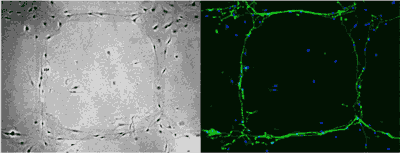Composite Biomaterials for Neurite Outgrowth in collaboration with Dr. Tayhas Palmore, Division of Engineering

Much of the previous research on biomaterial systems for nerve regeneration has examined the permissive capabilities of individual components or materials toward axon growth. These studies seek to quantify how composite biomaterials guide axon growth, giving particular attention to the complex problem of guidance by more than one component. Our working hypothesis is that composite biomaterials, presenting multiple growth-promoting cues, will enable axon growth to overcome a local environment that is inhibitory. Our long-term objective is twofold: to elucidate the cellular and molecular mechanisms that underlie axon guidance during development and after injury, and to develop biomaterial platforms to support and enhance axon growth. The important roles for glial cells, extracellular matrix molecules, and electrical stimulation in mediating axon growth have been established. How they interact and how they can be used in combination to direct axon growth is not well understood, however. This work combines microfabrication, electrochemistry, and primary cell cultures to generate a composite biomaterial substrate that is electrically conductive, embedded with growth-promoting proteins, and adheres supportive glial cells. Results from these studies will provide fundamental knowledge of how specific neural connections form during normal development and how they can be stimulated to regenerate following injury.


